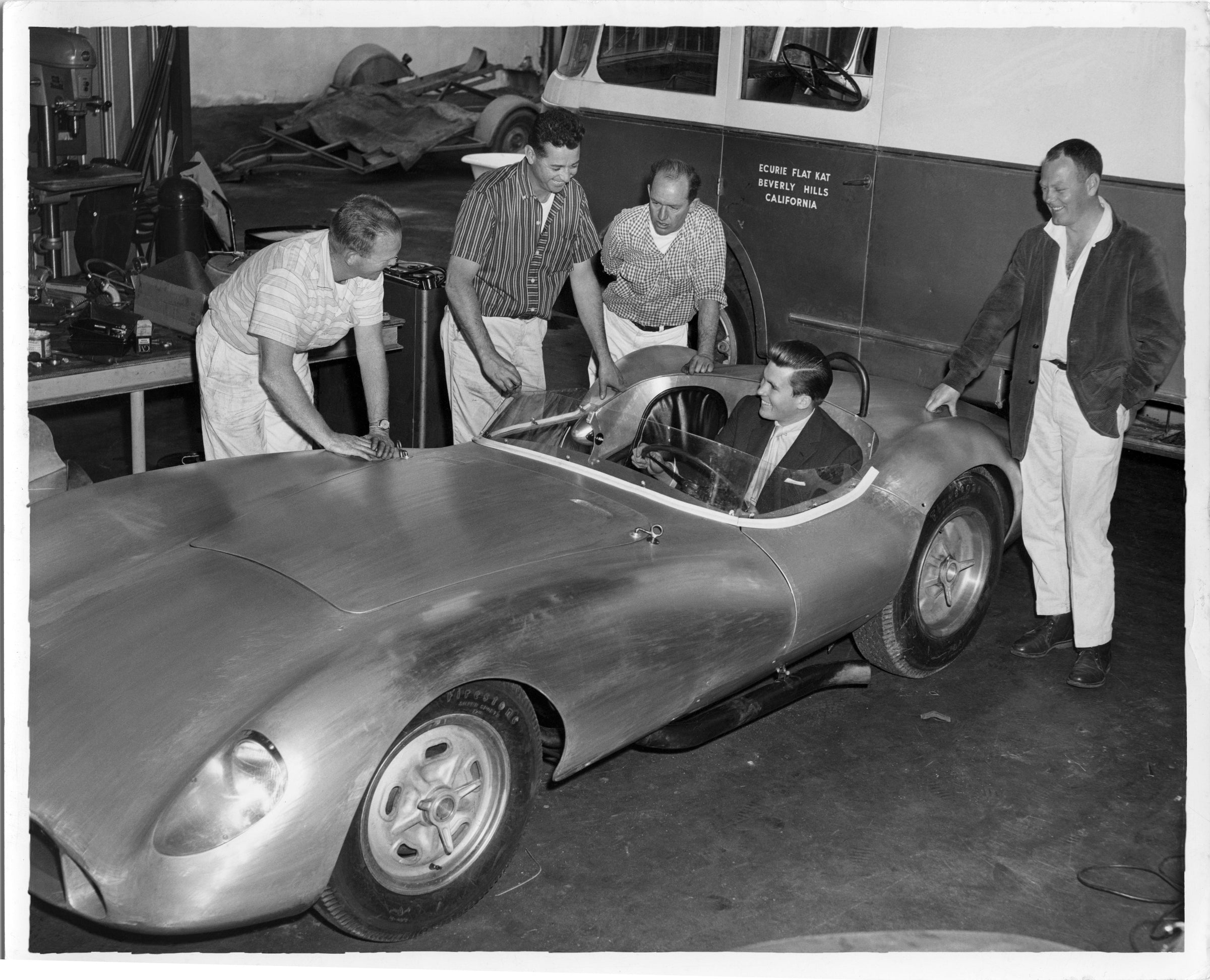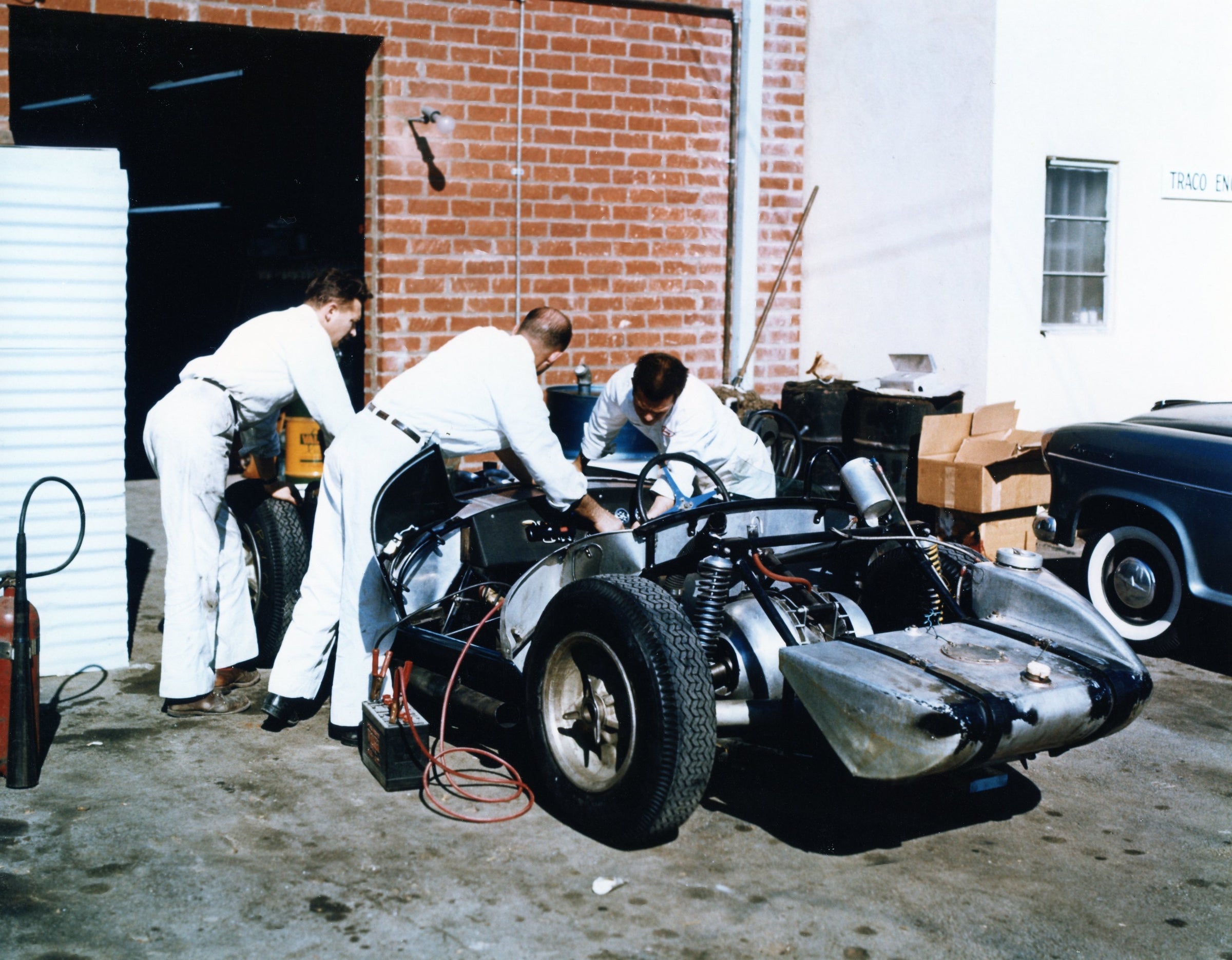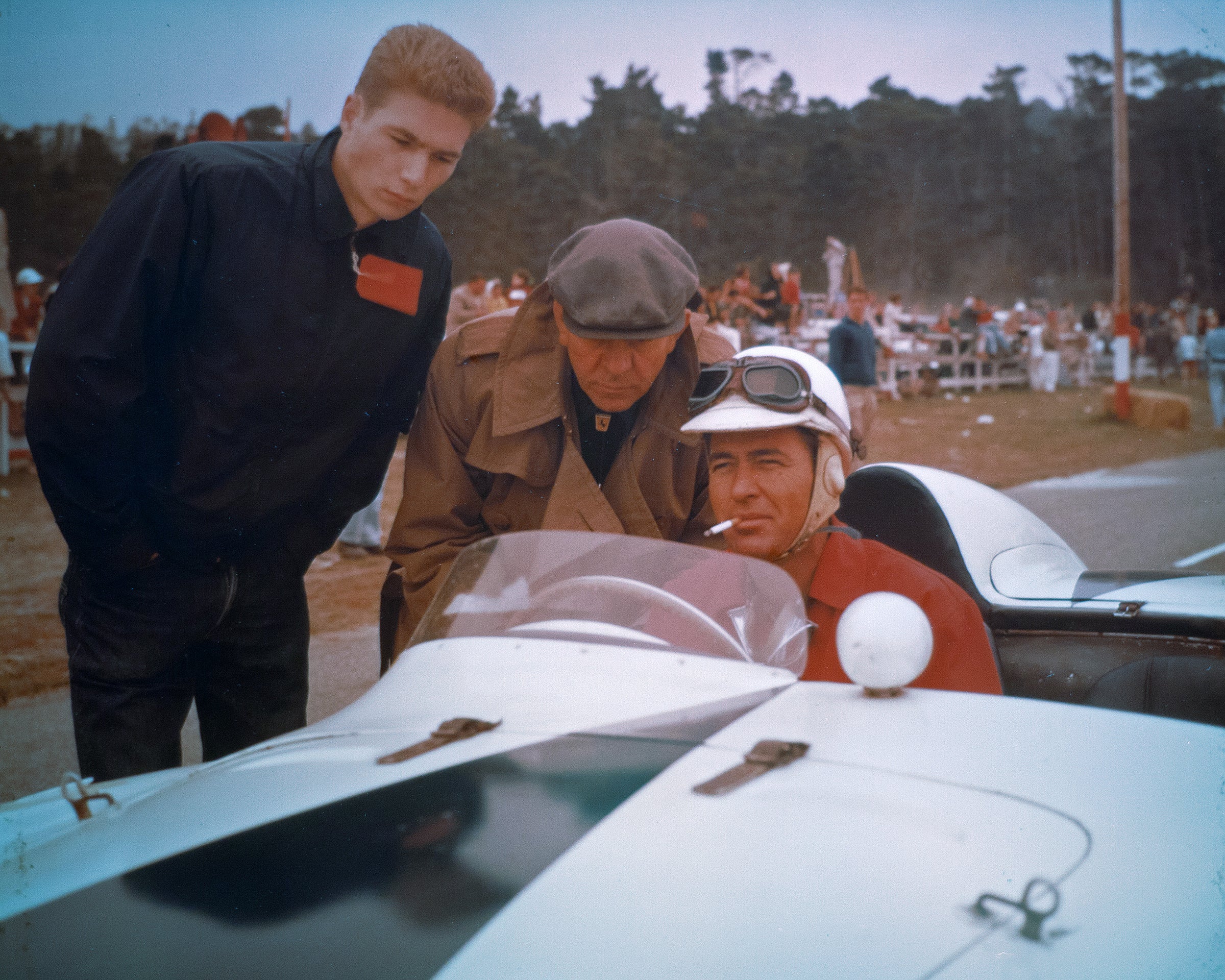Raoul ‘Sonny’ Balcaen
My exciting true-life story in motor racing from Top-Fuel drag-racing pioneer to Jim Hall, Reventlow Scarab, Carroll Shelby and beyond
- In stock, ready to ship
- Inventory on the way
Chapter 6
LANCE REVENTLOW
Let me sketch a picture of the real Lance Reventlow, as I saw him anyway. One day he sent his Rolls-Royce car to LAX airport to pick up a new houseguest, a gentleman from Europe that he’d never met.
Quite an important gentleman, a German aristocrat in fact, a descendant of nobility whose full name was Wolfgang Alexander Albert Eduard Maximilian Reichsgraf Berghe von Trips. The “Graf” part meant he was a Count. Thankfully his friends could just called him “Taffy.”
Von Trips was tall and slender, had the chiseled good looks you see in idealized portraits of European royalty, was extremely well educated and of course beautifully, impeccably mannered. On top of that he was a prominent Grand Prix racing driver. As a fully fledged member of the Ferrari factory racing team, he had earned distinction in both sports cars and Formula 1.
Why was he visiting a prominent Hollywood Playboy? Well, family connections, maybe. Lance happened to be a “Graf” too.
The chauffeur-driven Rolls duly picked up the distinguished guest at LAX and conveyed him back to the Reventlow homestead in Beverly Hills. Lance’s friend Bruce Kessler had gone along, to chat pleasantly and make von Trips feel welcome.
The chauffeur pulled smoothly into the drive, parked the elegant car with precision before the grand entrance, got out, turned his back, and strode away into the house.
Leaving Lance’s guest’s luggage untouched.
Red-faced with anger, Graf von Trips briskly followed into the salon in time to see the chauffeur plop himself down comfortably on one of the velvet sofas, take off his cap, and fling it carelessly onto a nearby matching chair.
Appalled, insulted, enraged, von Trips began fuming at the man’s arrogant, rude, disgraceful behavior. Timing it perfectly, the “chauffeur” stood back up, held out his hand with a big grin and said, “Hi, I’m Lance Reventlow!”
Ah yes, Lance Reventlow. One of the biggest characters I’ve ever met in racing or anywhere else. Knowing him was not only one of the most interesting experiences of my life, but our friendship led to a series of lucky opportunities for my career
Despite not being of noble lineage myself, I too was a guest in Lance’s home, and many times. Really, I was just a mechanic for Lance, working on cars like a Cooper 1100, a 2.0-liter Maserati, and a Mercedes-Benz 300 SL. Yet after work he’d often invite me up to Beverly Hills for one of his many parties. I didn’t look like a mechanic then, because by nature I try to always be clean and properly dressed.
Lance tried hard to be a Regular Guy. I guess I would too, if I was the only child and heir of one of the richest women in the world. Even back in the ’50s that meant very, very rich. Obscene wealth isn’t necessarily a good thing. I think one of the most revealing things Lance ever said was to a newspaper writer, who had asked why he wanted to be a race driver and build his own racecars.
“I want to prove I can do more than inherit money.”
Although Hollywood handsome and often called “Golden Boy,” Lance did not come from a happy family. His mother was Barbara Woolworth Hutton, heiress to the fortunes of the F. W. Woolworth retailing empire and financier E.F. Hutton. She was good looking, and spent her limitless inheritance ostentatiously, so she was attractive fodder for the tabloid press. “Poor Little Rich Girl,” is how the papers enjoyed referring to her with their characteristic tact and empathy. Her mother committed suicide. Her father ignored her. Isolated behind walls of money, what chance did she have of normal human relationships?
Lance’s father was a Danish Count, whose entire Gatling Gun of a name was Kurt Heinrich Eberhard Erdmann Georg von Haugwitz-Hardenberg-Reventlow. Reventlow senior was Ms. Hutton’s second husband, and he didn’t last much longer than the first. She had also married and divorced movie star Cary Grant before Lance was old enough to catch racing fever from husband no. 4.
Prince Igor Troubetzkoy was a French aristocrat of Russian descent, an athlete in both cycling and skiing, and an early Ferrari enthusiast. In 1947 he bought three of the very first Prancing Horses ever made, and in one of them he partnered driver Clemente Biondetti to take victory in the incredibly tough Targa Florio road race through the mountains of Sicily.
That was 1948. Lance was 12, and the excitement of his step-dad’s lifestyle made him a fan of European racing. In his teens Lance bought several exotic cars and drove some of them in competition. He was only modestly successful. Lance was a damn good driver, I thought, but a little hard on the equipment compared to some.
In those days, sports car racing was a gentleman’s sport and Lance fit the ticket as compared to hot rodding and drag racing, which were my passions. Most of the sports car drivers in his crowd were a sophisticated group in Beverly Hills and Hollywood.
My world was a little different. I grew up watching and then racing older sedans that we all souped up ourselves. When I got involved with sports cars it was to make a living, working on them during the day, then spending all my earnings building my own dragster at night.
You might not think Lance and I would have much in common, but we got along great. We were only a couple of months apart in age, maybe that was part of it. And we were both crazy for racing, that would have counted for more.
I found myself swept up in his social life, and Lance knew everyone in Hollywood. I’d go along to hang out with his friends at places like the Luau restaurant on Rodeo Drive, which was owned by Lana Turner’s husband, Steve Crane. Among the frequent diners were Ronnie Burns, the actor son of George Burns and Gracie Allen; the son of champion boxer Max Baer, actor Max Baer, Jr. who was in the Beverly Hillbillies TV show; and singer-songwriter Grace Slick, from Jefferson Airplane. They all seemed to accept me as a friend and contemporary.
One of the girls I particularly liked, although we were not dating, was named Celeste. She raised horses and I’d go riding with her. Her father was from Missouri, and started a Rent-a-Car company long before Hertz. Celeste’s brother was David Shane, a good friend of Bob Petersen who started Hot Rod magazine, and whom I would meet later. David was a hunter, like Bob.
Bruce Kessler was usually around, too, and he often got together with Ronnie Burns, who caught racing fever. Ronnie bought a Formula Junior car, a Lotus which was considered a Formula 1 training car. But one time Ronnie let Bruce run the little open-wheeler at Riverside, where he was badly injured when the car flipped over going through the series of swerves known as the Esses, much to Ronnie’s dismay and angst.
I soon met Lance’s manservant, Dudley Walker. A typical Brit, elegant and charming, he had been batman to a flying officer in the Royal Air Force during World War I. Dudley was in Cary Grant’s employ when Lance’s mother, Barbara Hutton, sent him to work for Lance, probably to watch over him.
Dudley loved automobiles and often came to the races with Lance. He always kept his car polished to perfection, really spiffy. He enjoyed talking about cars. I liked talking to him about what would be considered mundane matters, but I was curious about his duties at the house, about laying out Lance’s clothes, about making sure the cook prepared special meals when guests were expected.
Dudley was very distinguished-looking, and perfectly groomed with well-coiffed gray hair. He almost invariably dressed in coat and tie.
In fact, Dudley could have passed for a duke or an earl. He had, indeed, worked for an aristocrat, a British portrait painter, and accompanied him to the States in the late ’30s when his boss had a commission to paint a celebrity in New York.
I well remember that Dudley didn’t put up with fools, and would tell them to “bugger off” if they annoyed his employer or him. Lance was very fond of him, and vice-versa.
Years later, when I had my own company, Dudley and I often met for lunch. He’d teach me about wines, particularly French Bordeaux. I put the knowledge to good use later on as an oenologist, and as a member of the Los Angeles chapter of the Commanderie de Bordeaux. I became the person in charge of our wine cellar, the sommelier, so to speak. I strove to perform my duties in a manner to reflect credit on my mentor, Dudley Walker.
Bruce Kessler’s friendship with Lance began when they met at boarding school in Arizona, where both had been sent to treat asthma. They shared an interest in sports as well as cars, and became inseparable. Bruce was into boxing, and looked pretty tough. “People thought I was Lance’s bodyguard,” he says.
Bruce was not born to wealth like Lance, but his parents had built their own affluence so the two young men could afford to pursue their passion for racing. They spent a season together racing in Europe.
Returning to the States in 1955, 19-year-olds Lance and Bruce were living a celebrity-filled life in Hollywood. Lance married a starlet, Jill St. John, and the couple lived in Beverly Hills in a magnificent home on top of a hill with a 360-degree view. The Reventlows gave many parties that I attended.
Lance also became friends with fellow racer James Dean, who was starting a meteoric rise playing the role of a teenage rebel on the silver screen.
He wasn’t really acting. That fall, on September 30th, 1955, Lance and Bruce Kessler would be the last to talk to Dean while having a rest stop together at Blackwell’s Corner, a crossroads in the farm fields of the Central Valley about 150 miles north of Beverly Hills. They were all on their way to a road race in northern California near Monterey, Lance driving his Mercedes-Benz SL Gullwing coupe and the 24-year-old Dean driving with his mechanic, Rolf Wütherich, in his new Porsche 550 Spyder. “Little Bastard” was the name he had painted on his small, lightweight, very fast open-cockpit racecar.
After lunch they arranged to meet again for dinner, but Dean was soon stopped for speeding. After resuming his drive, barely 30 miles from the lunch stop he died in a high-speed, head-on crash approaching a blip on the map called Cholame. The mechanic somehow survived, as did the oncoming driver. A melancholy shrine to James Dean was put up near the spot and remains there to this day.
Lance and Bruce went ahead with their racing plans.
Lance was mechanically adept and knowledgeable about cars and engines, and at one point he took Kessler to the Lister racing car works in England. Listers were big sports racers that were dominating such racing in Great Britain. They normally carried six-cylinder, twin-cam Jaguar XK engines — Le Mans-winning engines — but Lance was thinking of buying a Lister and fitting it with a more powerful Chevy V8 (as other Yanks were).
What he saw in the Lister shop changed his mind. As he examined the car in detail, he found more and more things about the British chassis to criticize. It seems that voices were raised and arms began waving between Brian Lister and Lance. Finally, Lance walked away.
Outside, he declared to Bruce Kessler that in his opinion the Lister was a piece of crap and that he, Lance Reventlow, could build a better car! Bruce agreed. The two drivers came home, their heads filled with exciting plans to build an all-American sports racer.
Key content
• Aged 17, Balcaen built his own Top Fuel drag racer, the ‘Bantamweight Bomb’, which he developed relentlessly and drove to many successes.
• His role in the fabulous Scarab sports cars — the landmark all-American racers — and insights into life with their creator, the incomparable Lance Reventlow.
• Working as crew chief to the brilliant Jim Hall, preparing and running his Lotus Eleven and Lister-Chevrolet long before the famous Chaparrals emerged.
• A second spell with Scarab, this time with the Formula 1 project — the first American Grand Prix car — plus a special job for Reventlow converting a Scarab sports racer into a street car.
• Onwards into setting up his own successful business, IECO (Induction Engineering Co), to create and sell high-grade performance and appearance accessories, with Chevrolets — especially Corvair and Vega — featuring strongly.
• His many-faceted dealings with Carroll Shelby, leading to consultancy and even assignments as occasional Shelby American company pilot.
• Along the way we meet many other big names of the era, including Chuck Daigh, Bruce Kessler, Warren Olson, Dick Troutman, Tom Barnes, Phil Remington, Ken Miles, Leo Goossen, Jim Travers, Frank Coon and Pete Brock.
Format: 234x156mm
Hardback
Page extent: 320pp
Illustration: 102 photos, including colour
We deliver to addresses throughout the world.
UK Mainland delivery costs (under 2kg) by Royal Mail £5.00.
Books will normally be shipped within two working days of order. Estimated delivery times post shipment. UK: Up to 5 working days. Europe, Northern Ireland and Highlands and Islands: Up to 8 days. USA: Up to 12 days
IMPORTANT NOTICE FOR EU CUSTOMERS: Delivered Duty Unpaid (DDU) means that customers are responsible for paying the destination country's customs charges, duties. Regrettably parcels will sometimes be held by customs until any outstanding payments are made. Any payments not received may result in courier returning or in some cases destroying your books.
Unwanted products can be returned with the original packaging within 14 days of delivery. Returns will be at your own cost.
If you receive a faulty or damaged item please contact orders@evropublishing.com for return and replacement information.






















